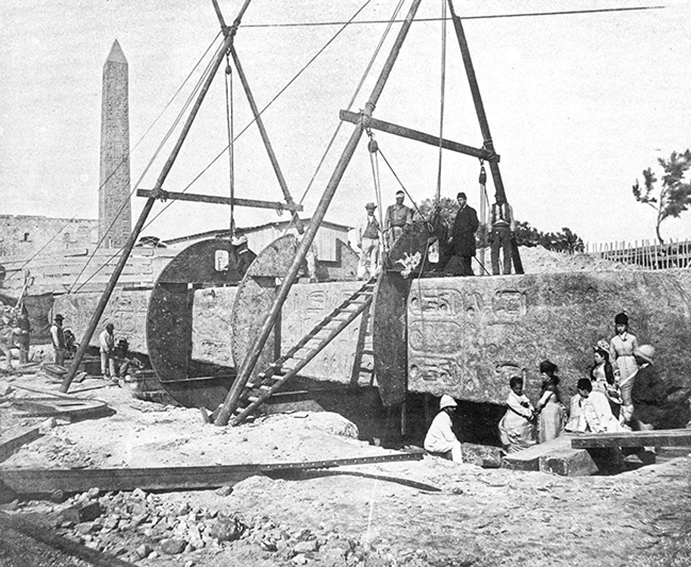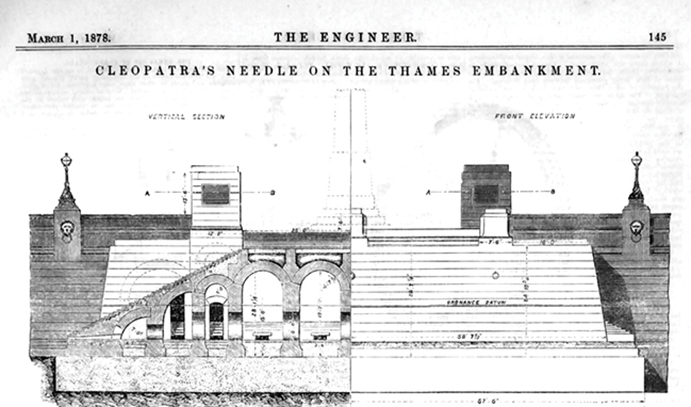Almost 140 years ago this month, an iconic antiquity appeared in The Engineer. Having arrived into London in January 1878 after a tumultuous journey, Cleopatra’s Needle was the centre of much attention. By March, a decision had been made on the location where it was to be sited, much to the chagrin of our predecessors.

“We regret that, in defiance of good taste, it has been decided to erect the obelisk on the Thames Embankment,” wrote The Engineer in 1878. “We have spoken so frequently and so strongly on the selection of a site, that we shall not further refer to the subject now.”
READ THE ORIGINAL ARTICLE HERE
We’ve been unable to ascertain exactly what ignited the protests of our forebears, but the issue appears to be one of form rather than function.
“It is well to know… that no objection can be urged on engineering grounds to the position secured on the Embankment; in other words, there is no fear that the monolith will tumble into the river, bringing a large section of the Embankment with it.”
No reference was made on these pages to the Needle’s history, which is a combination of the colourful and the tragic. Constructed during the reign of the 18th Dynasty Pharaoh Thutmose III, its red granite originated in quarries near Aswan. It was first erected in the Egyptian city of Heliopolis around 1450BC, but it was not until 200 years later that the monolith was inscribed with its distinctive Egyptian hieroglyphs, an addition made by Ramesses the Great to commemorate his military successes.
Moving tale
One of a pair – the other today sits in New York’s Central Park – the obelisk was moved to Alexandria by the Romans in 12BC, where it remained for almost two millennia. In 1819 it was presented to the UK in recognition of Nelson and Abercrombie’s respective victories in the battles of the Nile and Alexandria. However, the British government of the day declined to transport the 70ft artefact to London.
An effort to do so was undertaken in 1877 under Sir Erasmus Wilson, a well-known surgeon and dermatologist. But transporting the monolith, weighing 224 tons, would turn out to be a deadly endeavour. After being dug out of the sand, the Needle was placed into an iron cylinder that was 28m long and 5m wide, designed by the English railway engineer John Dixon. This ill-fated vessel, dubbed the Cleopatra, was equipped with a mast and rudder, two bilge keels and a deck house, and was intended to be towed to London by a ship called the Olga.

But on 14 October 1877, a storm in the Bay of Biscay sent the Cleopatra rolling uncontrollably. Six men were sent from the Olga to rescue the crew of the iron vessel, but their boat capsized and all were lost. Their names can be seen on a bronze plaque attached to the Needle’s mounting stone. The Olga was eventually able to pull alongside the Cleopatra and evacuate the sailors, with the cylinder and its precious cargo left to the mercy of the sea.
It was spotted four days later by Spanish trawlers, and brought to the port of Ferrol in Galicia by the Glasgow steamer Fitzmaurice. After repairs were carried out, the Cleopatra was eventually towed back to the Thames by the paddle tug Anglia. The diagrams from 1878 show how the Needle was secured to the Embankment after its journey.
“We give above [see illustration] a section of the river wall at the Adelphi Stairs, with the base of the Needle shown in dotted lines. From this it will be seen that a very large base is provided, and that the water stairs act as a buttress or relieving wall. The arched vaults are to be filled in solid with cement concrete. The only place where danger is to be apprehended is in the subway, the river haunch of the arch of which may be exposed to a considerable additional strain.”
The obelisk was finally erected on 12 September 1878. A time capsule was enclosed in the pedestal containing an array of both everyday and unusual items. These included a set of photographs of attractive English women; a baby’s bottle; a box of hairpins; a translation of the hieroglyphics; samples of the cable used in the Needle’s erection; a portrait of Queen Victoria; and a history of the monument’s journey to London. Good luck to future generations figuring out the meaning of all that.




Glasgow trial explores AR cues for autonomous road safety
They've ploughed into a few vulnerable road users in the past. Making that less likely will make it spectacularly easy to stop the traffic for...